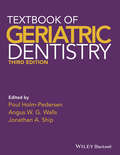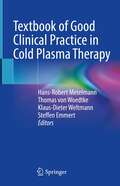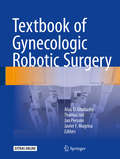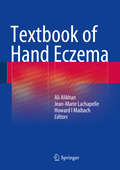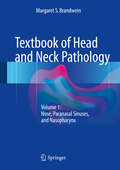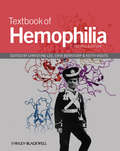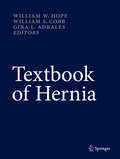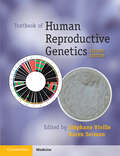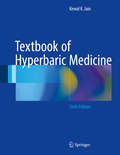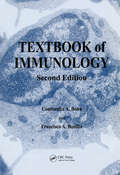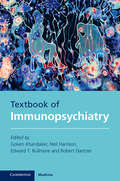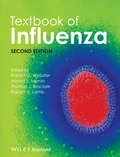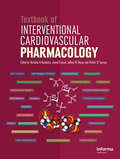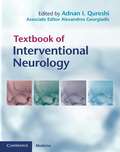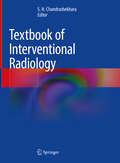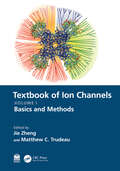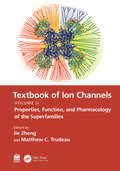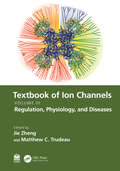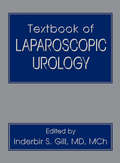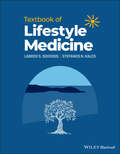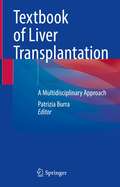- Table View
- List View
Textbook of Geriatric Dentistry
by Angus Walls Poul Holm-Pedersen Jonathan ShipTextbook of Geriatric Dentistry, Third Edition provides a comprehensive review of the aging process and its relevance to oral health and dentistry. Now in full colour, this third edition has been fully revised and updated with new material encompassing recent research and clinical developments within geriatric dentistry. Written in a clear and accessible style, this is an essential guide to geriatric dental practice for undergraduate and postgraduate dentistry students and practicing clinicians alike. Key features include: Contributions from an international group of expert authors Comprehensive coverage of oral healthcare issues in the older adult, from demographics and physiology through to nutrition and pharmacology Provides both foundational knowledge and a guide to clinical management New chapters including material on orofacial pain, quality of life and treatment planning
Textbook of Good Clinical Practice in Cold Plasma Therapy
by Hans-Robert Metelmann Thomas Von Woedtke Klaus-Dieter Weltmann Steffen EmmertThis textbook addresses the growing international need for a practical manual that teaches physicians how to apply cold atmospheric pressure plasma (CAP) in the day‐to‐day provision of patient healthcare.The book introduces readers to the concept of CAP, how it works, and how safe it is, before describing several diseases and other medical indications for its application. The book subsequently provides guidelines for daily clinical practice, e.g. for treating chronic wounds, decontaminating infected skin lesions, and rendering multi-resistant bacteria inert, as well as a detailed overview of plasma devices. In closing, it addresses organizational aspects, which are essential to cultivating and maintaining quality standards in the application of cold medical plasma.This textbook offers a unique educational resource and provides relevant information on plasma medicine as an emerging multidisciplinary discipline. Practitioners will appreciate this integrated, comprehensive guide, which is also suitable for advanced students of medicine and dentistry, and for nurses serving on plasma-assisted medical teams.
Textbook of Gynecologic Robotic Surgery
by Alaa El-Ghobashy Thomas Ind Jan Persson Javier F. MagrinaThis book is not only a compilation of the knowledge and experiences of the best robotic surgeons around the world, but it has also incorporated the recent advances and updates in Gynaecological surgery. It is designed to provide a detailed guide to common robotic Gynaecologic procedures for the purpose of helping novice surgeons in their transition to robotic surgery and seasoned robotic surgeons to refine their surgical technique and expand their repertoire of robotic procedures. The descriptive, step-by-step, text is complimented by figures, intraoperative photographs and videos detailing the nuances of each procedure. Emphasis is placed on operative setup, instrument and equipment needs and surgical techniques for both the primary surgeon as well as the operative assistant. This volume will provide unique insights into robotic Gynaecologic surgery and reduce the learning curve of accomplishing these increasingly popular procedures.
Textbook of Hand Eczema
by Howard I. Maibach Jean-Marie Lachapelle Ali AlikhanHand eczema is a major complaint worldwide and a frequent occupational disorder. This book provides a comprehensive and detailed overview of the classification, etiology, diagnosis, prevention, and therapy of hand eczema. It is innovative, up to date, and practical. The links with particular occupations are explained, the various diagnostic tests are presented, and the role of different topical and systemic treatments is clearly described. The authors are world leaders in the field. The "Textbook of Hand Eczema" reflects a new era in hand dermatitis and will be invaluable for all who deal with the condition in their clinical practice.
Textbook of Head and Neck Pathology
by Margaret S. BrandweinThe first of a multi-volume set, this textbook covers sinonasal and nasopharyngeal pathology. An ideal sign-out resource for head and neck pathology, it includes anatomy, staging, diagnostic, and prognostic information. Richly illustrated and well-structured, the easily accessible format includes glossaries, boxes of key points, and self-assessment questions at the end of each chapter. Nose, Paranasal Sinuses, and Nasopharynx: Textbook of Head and Neck Pathology: Volume 1 is aimed at trainees and practicing pathologists worldwide, and will also be of interest to oral pathologists and oral pathology trainees.
Textbook of Head and Neck Pathology: Volume 2: Mouth, Oropharynx, and Larynx
by Margaret S. Brandwein-WeberThe second of a four-volume set, this book covers oral cavity and oropharynx pathology. It’s goal is to become a “go-to” sign-out resource for head and neck pathology, incorporating anatomy, staging, diagnostic, and prognostic information. This richly illustrated volume has a bullet point format, where appropriate, allowing information to be easily located. This book is aimed at trainee and practicing pathologists in the USA and worldwide, and is also of interest to oral pathologists and oral pathology trainees.
Textbook of Hemophilia
by Erik E. Berntorp Christine A. Lee W. Keith HootsThe editors have included new authors and topics, and several chapters from second edition have been dropped. The overall organisation of the textbook has been changed in the light of changes of emphasis over the past 10 years. References have been restricted to create an overall succinct and comprehensive volume. A chapter on novel therapies in clinical trials or pre-clinical trials will be added at the time of going to press. The editors have consolidated the gene therapy section from three to two chapters, and retitled the Section, The Future of Haemophilia Therapy. The chapter on Old Age in Haemophilia has been extended to include more about survivorship with HCV/HIV and perioperative management (+/- anticoagulation in association with post-stent/cardiothoracic surgery following MI).Two areas that particularly needed reorganisation and rewriting were Inhibitors and Treatment to incorporate new products and future directions. Major new initiatives such as EUHASS have been incorporated. Furthermore, Ethical aspects of hemophilia care now merits a chapter on its own.
Textbook of Hemophilia
by Erik E. Berntorp Christine A. Lee W. Keith HootsTextbook of Hemophilia, 3rd edition Edited by Christine A. Lee, MA, MD, DSc, FRCP, FRCPath, FRCOG Emeritus Professor of Haemophilia, University of London, London, UK Erik E. Berntorp, MD, PhD Professor of Coagulation Medicine, Lund University Malmö Centre for Thrombosis and Haemostasis, Skåne University Hospital, Malmö, Sweden W. Keith Hoots, MD Director, Division of Blood Diseases and Resources, National Heart, Lung and Blood Institute National Institutes of Health, Bethesda, MD; Professor of Pediatrics and Internal Medicine, University of Texas Medical School at Houston, Houston, TX, USA Without doubt, Textbook of Hemophilia, 3rd edition is the definitive reference source on all aspects of haemophilia including diagnosis, management and treatment. Edited by three, world-renowned experts on haemophilia, this completely revised resource features chapters written by over 60 international contributors with international expertise in caring for haemophilia patients. Textbook of Hemophilia, 3rd edition Features eight new chapters, covering individualised dosing, vCJD and haemophilia, new drugs in the pipeline, and surgery in inhibitor patients Presents new developments, such as gene therapy Highlights controversial issues and provides advice for everyday clinical questions Represents essential reading for all healthcare professionals involved in the care of those with haemophilia Titles of related interest Hemophilia and Hemostasis: A Case-Based Approach to Management, 2nd Edition Ma, ISBN: 9780470659762 Current and Future Issues in Hemophilia Care Rodriguez-Merchan, ISBN: 9780470670576 www.wiley.com/go/hematology
Textbook of Hernia
by William W. Hope William S. Cobb Gina L. AdralesThis textbook provides a comprehensive, state-of-the art review of the field of hernia surgery, and will serve as a valuable resource for clinicians, surgeons and researchers with an interest in both inguinal and ventral/incisional hernia. This book provides an overview of the current understanding of the biologic basis of hernia formation as well as laying the foundation for the importance of hernia research and evaluating outcomes in hernia repair. Diagnosis and management strategies for inguinal and ventral hernia are discussed in detail with separate techniques sections for the most widely used procedures in this field as well as emerging technologies such a robotic and single incision surgery. Pertinent associated topics to inguinal hernia surgery such as chronic groin and athletic pubalgia are covered in detail. For incisional hernias, associated topics such as hernia prevention and enhanced recovery protocols are discussed. For both inguinal and ventral/incisional hernias mesh choices and available mesh technologies are discussed in detail as this remains an often confusing matter for the general surgery. When appropriate, chapters to highlight controversies in care are featured such as the use of synthetic mesh in contaminated surgery and laparoscopic closure of defects in laparoscopic ventral hernia repair. Current recommendations and outcomes data are highlighted when available for each technique. Textbook of Surgery will serve as a very useful resource for physicians and researchers dealing with, and interested in, abdominal wall hernias. It will provide a concise yet comprehensive summary of the current status of the field that will help guide patient management and stimulate investigative efforts.
Textbook of Human Disease in Dentistry
by Mark Greenwood John Meechan Robin SeymourThe Textbook of Human Disease in Dentistry is a comprehensive resource for all students of dentistry that provides uniquely integrated coverage of medicine, surgery, pharmacology, therapeutics, pathology and microbiology. It aims to provide its readers with the medical context of dentistry, to promote better understanding of how to provide effective dental treatment to patients affected by diseases and conditions. The Textbook of Human Disease in Dentistry is structured around the systems of the body and includes chapters on immunological disease, cardiovascular diseases, respiratory medicine, gastroenterology, dermatology, musculoskeletal disorders and neurological and special senses. A key aspect of the book is the relevance of particular diseases and/or their drug treatment to dentistry and in turn to patient dental management. Additional chapters are therefore provided on topics such as clinical examination and history taking, inflammation and anti-inflammatory drugs, infection control, pain and anxiety control, and care of the elderly. Filled with useful features and written in a lucid and accessible style, this book will provide its readers with a sound and accessible grounding in human diseases and their drug treatment and how they relate to dental care. Includes sections on all major diseases and conditions, describing aetiology, symptoms and treatment Places dentistry in a medical context, providing guidance on examination and treatment protocols Features information on drug treatment and planning dental care around it Illustrated with helpful clinical photographs, showing diseases and conditions
Textbook of Human Reproductive Genetics
by Stéphane Viville Karen D. SermonA basic understanding of human genetics is vital for all those working in the field of assisted human reproduction. Genetic makeup can hamper reproduction and insight into this is making genetic diagnosis and counselling increasingly important. This fully updated textbook continues the clear structure of the original edition, beginning with a chapter on the basics of genetics and cytogenetics. Genetic causes of infertility and the effect of epigenetics and transposons on fertility are discussed in detail. Several new chapters are included in this edition, reflecting the advances of the field, including preconception genetic analysis and screening in IVF and mitochondrial genetics. Combining genetics, reproductive biology and medicine, this is an essential text for practitioners in reproductive medicine and geneticists involved in the field looking to improve their knowledge of the subject and provide outstanding patient care.
Textbook of Hyperbaric Medicine
by Kewal K. JainThis comprehensive volume captures the latest scientific evidence, technological advances, treatments and impact of biotechnology in hyperbaric oxygen therapy. Divided into three distinct sections, the book begins with basic aspects that include history, equipment, safety and diagnostic approaches; this is followed by clinical applications for hyperbaric oxygen therapy in various modalities; the last section provides an overview of hyperbaric medicine as a specialty with best practices from around the world. Integration of multidisciplinary approaches to complex disorders are also covered. Updated and significantly expanded from previous editions, Textbook of Hyperbaric Medicine, 6th Edition will continue to be the definitive guide to this burgeoning field for students, trainees, physicians and specialists.
Textbook of Hyperbaric Medicine
by Kewal K. JainThis comprehensive volume captures the latest scientific evidence, technological advances, treatments and impact of biotechnology in hyperbaric oxygen therapy. Divided into three distinct sections, the book begins with basic aspects that include history, equipment, safety and diagnostic approaches; this is followed by clinical applications for hyperbaric oxygen therapy in various modalities; the last section provides an overview of hyperbaric medicine as a specialty with best practices from around the world. Integration of multidisciplinary approaches to complex disorders are also covered.Updated and significantly expanded from previous editions, Textbook of Hyperbaric Medicine, 6th Edition will continue to be the definitive guide to this burgeoning field for students, trainees, physicians and specialists.
Textbook of Immunology
by Constantin A. Bona Francisco A. BonillaBuilding on the strengths of the first edition, the newly titled and expanded second edition remains a concise introduction to the fundamentals of immunology, with an expert synthesis of basic and clinical information., Augmented by color illustrations, and with increased emphasis on the molecular and genetic underpinnings of cellular phenomena, Textbook of Immunology covers the physiology of the immune system, disease entities related to immune system dysfunction, and the underlying pathophysiologic mechanisms of dysfunction. In response to advancing knowledge that influences the approach to presenting basic immunology, new chapters have been added on cytokines; host defense (non-specific immunity and specific immune responses); the aging immune system; and the pathophysiology, diagnosis, prevention, and therapy of AIDS., This book keeps pace with the explosion of information and data in immunology, and adeptly refines, organizes, and presents this body of knowledge to serve as a succinct introduction to modern immunologic concepts for medical students, and as an update and refresher in the basics for researchers and clinicians.
Textbook of Immunopsychiatry
by Edward Bullmore Neil Harrison Robert Dantzer Golam KhandakerThe rapidly growing field of immunopsychiatry combines expertise and insights from immunology, psychiatry and neuroscience to understand the role of inflammation and other immune processes in causing and treating mental illness. This represents a major shift in mental health science, traditionally focused on psychological and neuronal mechanisms of depression, psychosis and dementia. This book provides the first comprehensive overview of recent, inter-disciplinary research linking disordered function of the immune system to the brain and mental illness. It offers a broad and deep perspective on the implications of immune system involvement in psychiatric disorders, including a balanced focus on basic science and clinical applications. Chapters cover the scientific evidence linking immune processes to major mental illnesses such as schizophrenia, depression, anxiety and dementia. An invaluable guide for graduate students, doctors in training, scientific researchers and others interested in the link between the immune system and mental health.
Textbook of Influenza
by Arnold S. Monto Robert G. Webster Thomas J. Braciale Robert A. LambThe Textbook of Influenza is a comprehensive resource covering all aspects of influenza, from the genetic and molecular biology of the virus through to clinical aspects of the disease and the latest drug developments and treatments. This new edition has been completely revised and reflects the integration of disciplines concerning the emergence, evolution, pathogenesis and control of influenza viruses in the field of human and veterinary public health.Textbook of Influenza examines the lessons learnt from the latest pandemic and provides the current state of knowledge for many yet unresolved issues related to virus origin, spread, pathogenesis and disease severity to better prepare for future pandemics. It covers the background to recent advances in influenza genomics and reverse genetics which have allowed the identification of virus virulence factors and the analysis and reconstruction of influenza viruses such as the 1918 Spanish flu strain.This new edition is divided into eight key sections, containing chapters co-written by international experts from both the clinical and scientific communities, covering:* Influenza Perspectives* Structure and Replication* Evolution and Ecology* Epidemiology and Surveillance* Immunology* Vaccines and Vaccine Development* Clinical Aspects and Antivirals* Public HealthTextbook of Influenza is for all those working in the area of influenza including clinical and basic scientists, immunologists, molecular and structural virologists, public health officials and global pandemic control planners.
Textbook of Interventional Cardiovascular Pharmacology
by Jawed Fareed Nicholas N. Kipshidze Patrick W. Serruys Jeffrey W. MosesWhile all interventional cardiologists have access to pharmacopeial texts and databases and are aware of the growing number of pharmacological agents in the armamentarium, questions arise as to the ideal agent or combination of agents in differing patient situations. This superb text offers the reader coverage of all the major pharmacological t
Textbook of Interventional Neurology
by Adnan I. Qureshi Alexandros L. Georgiadis"Endovascular intervention - using medication and devices introduced through catheters or microcatheters placed into the blood vessels through a percutaneous approach - has emerged as a relatively new minimally invasive approach to treat cerebrovascular disease and possibly intracranial neoplasms. This textbook provides a comprehensive review of principles pertinent to endovascular treatment of cerebrovascular diseases and intracranial tumors, with a detailed description of techniques for these procedures and periprocedural management strategies. Particular emphasis is placed on expert interpretation of the quality of evidence provided and implications for practice related to endovascular procedures. This will be essential reading for clinicians working in interventional neurology and cardiology, endovascular neurosurgery, vascular surgery and neuroradiology"--Provided by publisher.
Textbook of Interventional Radiology
by S. H. ChandrashekharaThe textbook covers all the aspects of interventional radiology (IR), ranging from anatomy, pre-procedural evaluation, technique, post procedure care, and complications. It provides a comprehensive overview of both vascular and non-vascular interventions and thus fills the gap in the existing literature. The Initial chapters of the book focus on the hardware, drugs, contrast media, and imaging systems used in IR enabling the reader to become oriented to the interventional techniques that are covered in the subsequent chapters. Each chapter in the book focuses upon a particular set of interventions on an organ or organ system from head to toe, thereby facilitating convenient reading by the users. This book is designed not only to guide trainees enrolled in super-specialty and fellowship courses in interventional radiology (IR) but also to offer foundational IR training for general radiologists, effectively bridging the gap between general radiology and IR. It equips trainees with all the essential knowledge needed to practice IR and prepare for exams such as FRCR, EDiR, RANZCR, DM, and fellowship examinations. Additionally, it serves as a valuable reference for both practicing general radiologists and interventional radiologists. The book is relevant for MD/DNB trainees in radiology/radiodiagnosis, DM/DNrB trainees in interventional radiology/ neuroradiology/ cardiovascular radiology, and fellowship trainees in interventional radiology and its subspecialties.
Textbook of Ion Channels Volume I: Fundamental Mechanisms and Methodologies
by Jie Zheng Matthew C. TrudeauThe Textbook of Ion Channels is a set of three volumes providing a wide-ranging reference source on ion channels for students, instructors and researchers. Ion channels are membrane proteins that control the electrical properties of neurons and cardiac cells; mediate the detection and response to sensory stimuli like light, sound, odor, and taste; and regulate the response to physical stimuli like temperature and pressure. In non-excitable tissues, ion channels are instrumental for the regulation of basic salt balance that is critical for homeostasis. Ion channels are located at the surface membrane of cells, giving them the unique ability to communicate with the environment, as well as the membrane of intracellular organelles, allowing them to regulate internal homeostasis. Ion channels are fundamentally important for human health and diseases, and are important targets for pharmaceuticals in mental illness, heart disease, anesthesia, pain and other clinical applications. The modern methods used in their study are powerful and diverse, ranging from single ion-channel measurement techniques to models of ion channel diseases in animals, and human clinical trials for ion channel drugs.Volume I, Part 1 covers fundamental topics such as the basic principles of ion permeation and selectivity, voltage-dependent, ligand-dependent, and mechano-dependent ion channel activation mechanisms, the mechanisms for ion channel desensitization and inactivation, and basic ion channel pharmacology and inhibition. Volume I, Part 2 offers a practical guide of cardinal methods for researching ion channels, including heterologous expression and voltage-clamp and patch-clamp electrophysiology; isolation of native currents using patch clamping; modeling ion channel gating, structures, and its dynamics; crystallography and cryo-electron microscopy; fluorescence and paramagnetic resonance spectroscopy methods; and genetics approaches in model organisms.All three volumes give the reader an introduction to fundamental concepts needed to understand the mechanism of ion channels; a guide to the technical aspects of ion channel research; a modern guide to the properties of major ion channel families; and includes coverage of key examples of regulatory, physiological and disease roles for ion channels.
Textbook of Ion Channels Volume II: Properties, Function, and Pharmacology of the Superfamilies
by Jie Zheng and Matthew C. TrudeauThe Textbook of Ion Channels is a set of three volumes that provides a wide-ranging refer- ence source on ion channels for students, instructors and researchers. Ion channels are membrane proteins that control the electrical properties of neurons and cardiac cells; mediate the detection and response to sensory stimuli like light, sound, odor, and taste; and regulate the response to physical stimuli like temperature and pressure. In non-excit- able tissues, ion channels are instrumental for the regulation of basic salt balance that is critical for homeostasis. Ion channels are located at the surface membrane of cells, giving them the unique ability to communicate with the environment, as well as the membrane of intracellular organelles, allowing them to regulate internal homeostasis. Ion channels are fundamentally important for human health and diseases, and are important targets for pharmaceuticals in mental illness, heart disease, anesthesia, pain and other clinical appli- cations. The modern methods used in their study are powerful and diverse, ranging from single ion-channel measurement techniques to models of ion channel diseases in animals, and human clinical trials for ion channel drugs. Volume II starts with ion channel taxonomy and features coverage of major ion channel families, and describes the physiological role, structural components, gating mechanisms and biophysics, permeation and selectivity, regulation, pharmacology, and roles in dis- ease mechanisms. Channels in this volume include voltage-activated sodium, calcium and potassium channels, inward-rectifier and two-pore domain potassium channels, calcium- activated potassium channels, cyclic nucleotide-gated channels, pacemaker ion channels, chloride channels, ligand-gated receptors activated by acetylcholine, glutamate, 5-HT3, GABA and glycine, acid-sensing channels, P2X receptors, TRP channels, store-operated channels, pressure-activated piezo channels, ryanodine receptors, and proton channels. All three volumes give the reader an introduction to fundamental concepts needed to understand the mechanism of ion channels; a guide to the technical aspects of ion channel research; offer a modern guide to the properties of major ion channel families; and include coverage of key examples of regulatory, physiological and disease roles for ion channels.
Textbook of Ion Channels Volume III: Regulation, Physiology, and Diseases
by Jie Zheng and Matthew C. TrudeauThe Textbook of Ion Channels is a set of three volumes that provides a wide-ranging reference source on ion channels for students, instructors and researchers. Ion channels are mem- brane proteins that control the electrical properties of neurons and cardiac cells; medi- ate the detection and response to sensory stimuli like light, sound, odor, and taste; and regulate the response to physical stimuli like temperature and pressure. In non-excitable tissues, ion channels are instrumental for the regulation of basic salt balance that is critical for homeostasis. Ion channels are located at the surface membrane of cells, giving them the unique ability to communicate with the environment, as well as the membrane of intracellular organelles, allowing them to regulate internal homeostasis. Ion channels are fundamentally important for human health and diseases, and are important targets for pharmaceuticals in mental illness, heart disease, anesthesia, pain and other clinical appli- cations. The modern methods used in their study are powerful and diverse, ranging from single ion-channel measurement techniques to models of ion channel diseases in animals, and human clinical trials for ion channel drugs. Volume III includes coverage of key ion channel regulators and their mechanisms, the role of ion channels working in concert in selected physiological systems, and examples of ion channel mutations and dysfunction in a selection of diseases. Chapters on ion channel regulation include splice variants, calcium–calmodulin regulation, regulation by G pro- teins, and lipids. A selection of ion channels in physiological systems includes ion chan- nels of the heart, ion channels in immune cells and their role in pancreatic beta cells and regulation of insulin secretion, and the role of channels in sperm and eggs. While disease mechanisms are integrated into the chapters of Volume II, Volume III offers special consid- eration of ion channels in epilepsy, cystic fibrosis and pain syndromes. All three volumes give the reader an introduction to fundamental concepts needed to understand the mechanism of ion channels, a guide to the technical aspects of ion channel research, offer a modern guide to the properties of major ion channel families, and includecoverage of key examples of regulatory, physiological, and disease roles for ion channels.
Textbook of Laparoscopic Urology
by Inderbir S. GillDivided into eleven detailed sections, this reference displays the expertise and research of specialists from leading urology centers around the world and offers authoritative chapters on the entire spectrum of urologic laparoscopy. The chapters cover methods in patient selection, peri-operative management, and complication avoidance; step-by-step
Textbook of Lifestyle Medicine
by Labros S. Sidossis Stefanos N. KalesTextbook of Lifestyle Medicine The Textbook of Lifestyle Medicine provides foundational knowledge essential to students and scientists across various disciplines to better understand this new area of research and practice. Incorporating the latest evidence-based research on the relationships between lifestyle factors and disease, this unique book discusses the practical tools necessary to address growing public health crises such as obesity, cancer, diabetes, and cardiovascular disease using a holistic approach to physical, mental, and spiritual wellness. The book offers comprehensive and up-to-date coverage of how lifestyle medicine professionals can prevent and mitigate ‘Lifestyle Diseases’. Clear and accessible chapters explore modifiable lifestyle factors that positively affect health, nutrition, exercise, sleep, stress control, and social support, and highlight the negative impact of smoking, alcohol abuse, and other unhealthy lifestyles. Topics include sleep physiology, the genetic background and development of noncommunicable diseases (NCDs), the characteristics and principles of healthy lifestyle, the clinical significance of physical activity, and the mechanisms connecting social interaction and health implications. This important resource: Discusses the global burden and risk factors of the modern disease epidemic Covers a variety of nutritional approaches including the Mediterranean Diet and the Dietary Approaches to Stop Hypertension (DASH) diet Features in-depth coverage of the Mediterranean Lifestyle, a holistic approach to health and wellness Includes a clinical practice section and appendices on preventive medicine and public health tools and recommendations Contains key points, take-home messages, self-assessment questions, color artwork and numerous references, citations, internet links, and further reading suggestions Written by two world experts in this growing field, the Textbook of Lifestyle Medicine is a must-have volume for students and practitioners in nutrition, exercise physiology, psychology, addiction therapy, sleep therapy, as well as physicians, nurses, and other health professionals wanting to expand their knowledge and practice.
Textbook of Liver Transplantation: A Multidisciplinary Approach
by Patrizia BurraLiver transplantations require a complex and varied, multidisciplinary approach involving not only hepatologists and surgeons but also pathologists, psychologists, professional educators, nurses and, in the case of young patients, also pediatricians and development experts. This textbook provides an overview of the management problems involved in liver transplantation for acute and chronic liver disease, pediatric liver transplantation and the psychosocial aspects of liver transplantation. A closing chapter, focusing on the developments and future prospects in liver transplantation, outlines the potential offered by donors after cardiac death, cell therapies and organogenesis. The multidisciplinary approach is also maintained in the selection of authors, all experts actively engaged in the various disciplines involved in liver transplantations. This aspect, together with its precise and didactic descriptions of all phases of liver transplantation for chronic and acute diseases – from managing waiting lists to post-transplant complications – make the book a valuable tool for fellows, trainees, and specialists in the field seeking accurate framework for liver transplantation in its many facets.
